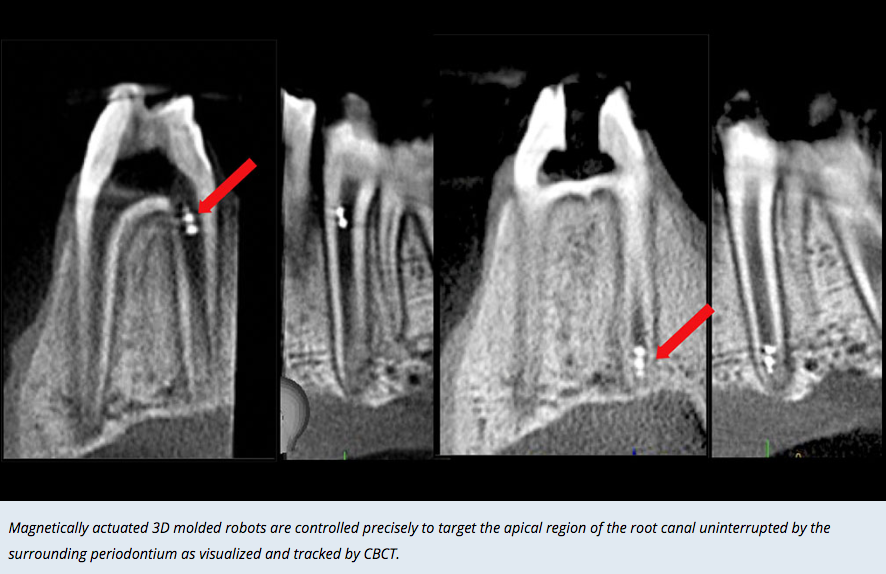Microrobotics in endodontics – the future is here
Featured Products Promotional FeaturesPosted by: Dental Design 27th November 2022

As someone who has dedicated my life to endodontics, it never fails to inspire me when I think about how far we’ve come in the last few years – and what lays in store for us in the future. It seems that every time I read the latest research we are making more and more significant steps forward, especially in areas such as microrobotics.
So, what are the latest breakthroughs in microrobotics and what will these innovations mean for the future of endodontics?
A complex arm of dentistry
It’s no overstatement to say that endodontic treatment can be incredibly complicated. The root canal system presents a number of anatomical complexities and irregularities, and the fact that that every patient will present with different challenges means that even the most advanced treatment approaches can still fail, especially if a canal is missed or any biofilm remains.
Biofilm that is not removed during treatment remains a leading cause of endodontic treatment failure and persistent infections.[i] Unfortunately, until an infection occurs, it can be difficult to tell if the treatment has been successful, and failure rates following endodontic treatment can vary wildly depending on the type of tooth that needed treatment, the skill level of the practitioner and the methods employed during the treatment process.[ii]
Although success rates of endodontic treatment have only continued to rise in recent years, current estimates suggest that there is a failure rate of anywhere between 2-14%.[iii] This means that there is still space for significant improvement – but is microrobotics the answer?
Revolutionary innovations
New reports from Penn Dental Medicine and its Centre for Innovation & Precision Dentistry (CiPD) reveal that microrobotics (microscopic particles imbued with certain characteristics rather than small machines) could be the answer we’re looking for to enhance endodontics and help significantly reduce any remaining margin of error.
Experts proved that microrobots could be engineered to access the difficult surfaces and spaces in the root canal system, reliably removing biofilm in these areas and even retrieving samples for diagnosis if necessary.[iv] Additionally, these minuscule particles could also be engineered to deliver drugs to these sites, aiding processes such as endodontic retreatment when infection has occurred or helping to ensure proper cleaning of the canal in the first place.
Researchers have shared these findings after testing two different microrobotic platforms that were specifically designed for endodontic surgery. In both cases, the nanoparticles were controlled in different ways to achieve the results, indicating the versatility of this type of technology. In the first method, the microrobots were controlled via a magnetic field and herded into “microswarms” that acted as one unit, disrupting biofilm using catalytic reactions. The secondary method utilised 3D printed, helix-shaped microrobots that were embedded with iron oxide nanoparticles. These too were manipulated using magnetic fields, navigating the root canal system to deliver drugs and bioactives.
Perhaps what is most fascinating about this breakthrough is that these microrobots can be harnessed for both diagnostic and therapeutic applications. By using microswarms to eradicate biofilm or collect samples, this opens the door to clinicians being able to assess which microorganisms caused any infection in the first place, allowing for targeted treatment to help resolve the issue more swiftly. Plus, these microrobots eliminate the needs for complex tools and, effectively, achieve a better result, as they target all active biofilm and can navigate the narrow and difficult spaces in the root canal system far more efficiently that any hand-guided tool.

Endodontics today and in the future
With such a significant breakthrough by this team of researchers, I don’t think it will be long until this sort of technology will be harnessed on a wider scale. The researchers themselves have stated that these microrobots have potential for both in practice and at home applications, which could very well be the key to better oral health for everyone – as long as there is a viable way to make this technology available on a wide scale.
As ever, with innovations like these it’s easy to look towards a brighter future, but we’re not there quite yet. However, I can’t wait to see this sort of technology being utilised in practice and at home. We’re on the brink of a great change, so it’ll be exciting to see where these innovations take us.
For further information please call EndoCare on 020 7224 0999
Or visit www.endocare.co.uk
EndoCare, led by Dr Michael Sultan, is one of the UK’s most trusted Specialist Endodontist practices. Through the use of the latest technologies and techniques, the highly-trained team can offer exceptional standards of care – always putting the patient first. What’s more, EndoCare is a dependable referral centre, to which dentists from across the country send their patients for the best in specialist endodontic treatment.
[i] Siqueira Jr. et al. Aetiology of Root Canal Treatment Failure: Why Well-treated Teeth Can Fail. International Endodontic Journal. 2001, 34 (1). 1-10.
[ii] Iqbal, A. et el. J Clin Diagn Res. 2016 May; 10(5): ZC146–ZC148.
[iii] Tabassum, S. et al. Eur J Dent. 2016 Jan-Mar; 10(1): 144–147.
[iv] Science Daily. Microrobotics in Endodontic Treatment, Diagnostics. Link: https://www.sciencedaily.com/releases/2022/08/220809141136.htm [Last accessed August 22].
IMAGE taken from: https://www.dental.upenn.edu/news-events/2022/08/05/penn-dental-medicine-study-applies-microrobotics-in-endodontic-treatment-diagnostics/








